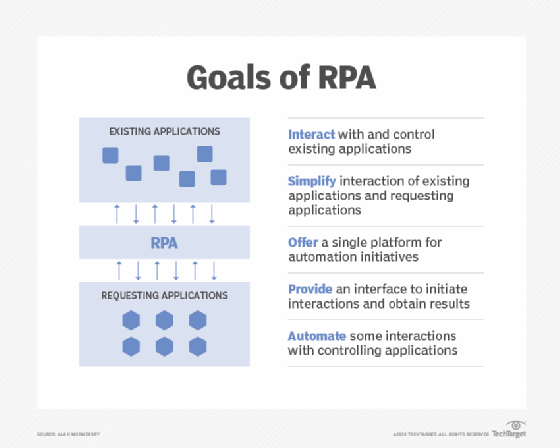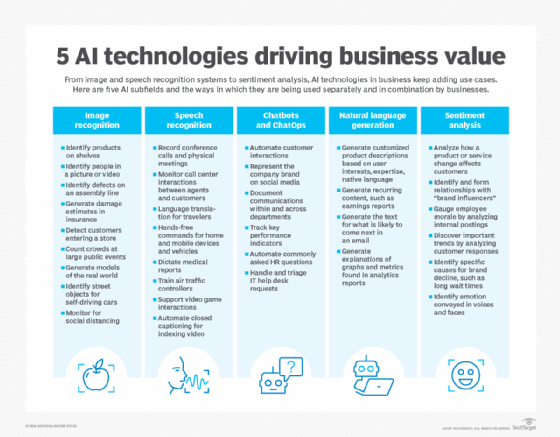
kirill_makarov - stock.adobe.com
Understanding the difference between RPA and AI
RPA and AI adoption are rapidly increasing, but there's still some confusion over the coevolving technologies. Here we dive into their capabilities and how they can work together.
CIOs are implementing both automation and AI at a quickening pace, prodded into expanding and expediating deployments for the speed and cost-saving efficiencies they each deliver.
Recently released figures quantify the accelerating rate of adoption. More than 72% of global enterprises already started AI implementations, according to a January report from Everest Group. The firm expects that global spending on AI services will accelerate by 32%, from $25 billion in 2019 to $95 billion by 2024.
The global robotic process automation (RPA) software market hit $1.2 billion at the end of 2019, posting year-on-year growth of more than 75%. Although the rate of expansion slowed in 2020 following the pandemic, it's ticking up heading into 2021. Everest Group predicts that pent-up demand for automation will drive the RPA market, with an expected compound annual growth rate of nearly 50% over the next two years.
This isn't surprising, as RPA and AI bring numerous benefits to an organization: streamlined processes, cycle time reduction and ultimately better business outcomes. The overarching return, according to experts, is not only faster processing of the end-to-end business cycle, but a more responsive business overall.
Although organizations can expect benefits when deploying each technology on its own and independent of the other, experts stressed that enterprises deploying RPA and AI technologies together can expect bigger returns and a more competitive stance in the modern digital market as a result.
"It's always AI plus RPA for us; it's part of end-to-end transformation," said Bhooma Chutani, head of digital transformation consulting at Larsen & Toubro Infotech Ltd.
But first, what are the capabilities of RPA and how does it differ from AI?
RPA deployments
RPA is the use of software robots -- or bots -- to perform standardized, repeatable tasks within a business process. These bots perform the same tasks every time and can do it faster and more reliably than human workers, thus bringing speed and efficiency while reducing costs and errors and leaving people to handle the more complex higher-value jobs that only humans can manage.

"It's easy to implement for processes that are very structured, very action-oriented. It's easy to get benefits quickly -- it's an easy win," Chutani added, noting that many organizations have already deployed RPA to perform at least some of their repetitive tasks.
The capabilities and the value of RPA have their limits, though. While the software can perform repetitive tasks at a speed, scale and accuracy level that far exceeds human workers, RPA cannot deviate from the tasks that it is programmed to do.
"You can use RPA for a lot of processes. But at some point, you need a decision; most processes [will] have a need for an intelligence component. That's where we talk about needing a human in the loop," Chutani said.
The role of AI in processes
This is where AI steps in: AI can mimic human decision-making, which RPA is not capable of. Moreover, AI can learn how to improve its work as it makes those decisions by rapidly identifying and analyzing patterns in data at a speed and scale that is impossible for humans to match.
Implementing AI, however, is more challenging than deploying RPA. Foremost, there is the challenge around getting the data needed to train the AI.
"AI needs a lot of data to build out those models and most organizations don't have a good handle on their data to quickly or easily introduce AI," Chutani said.
Then there's the cost. AI initiatives have a higher cost than RPA projects, with AI systems training taking months or more to complete before it can be put into operation. AI projects also require more expertise to develop, deploy and maintain, which can be expensive and hard to find.
Additionally, CIOs and other executives often lack a full understanding of their business processes and it's something they need to tackle in order to move ahead with their AI programs.
"If I could tell CIOs to do one thing and one thing only, it's to have complete visibility over the process that they are going to automate; they need that end-to-end visibility," said Cathy Tornbohm, an analyst with Gartner.
Experts also noted that many executives remain cautious about -- if not outright opposed to -- turning over decision-making capabilities to computers, particularly in any areas that fall under government regulatory controls or in ways that could jeopardize their own or others' jobs.
Given all that, experts said they're seeing a slower adoption rate for AI than RPA.
However, the technology remains a top priority among business and IT leaders. A 2020 survey from software provider IFS found that AI topped the list of technologies prioritized by leaders, with 24% of respondents expecting it to be a leading technology over the next two years, ahead of other trending technologies including virtual and augmented reality, IoT, blockchain and 5G.

Bringing RPA and AI together
Chutani pointed to invoice processing as an example of how organizations can deploy both RPA and AI to a business process to maximize results.
Instead of human workers manually transferring data from one file or system to another, RPA software can retrieve required data from predetermined fields on submitted invoice forms and send it to the predetermined enterprise systems.
AI is then used to handle the complex tasks along that business process. For example, natural language processing -- a type of AI capable of understanding human language -- can identify emails that include invoices and send them to bots for processing. The AI would then pick up the process again to determine which invoices meet the requirements for issued payments by sending the approved invoices onto payment systems and diverting the rejected invoices to human managers who would determine next steps.
According to Tornbohm, the use of RPA alongside AI moves enterprises into the realm of hyperautomation, which unites various technologies to automate not just tasks within business processes, but as much of the decision-making aspects within the processes as possible.
"[Essentially it] means you're going to take a person out of the process," Tornbohm said.
Experts believe most organizations have a ways to go before achieving that state, as IT leaders who moved toward hyperautomation are still piecing together their RPA and AI capabilities.
The market is changing, though, with some vendors offering both automation and AI capabilities together -- a move that, along with increasing interest and pressure for speed and agility, could bring more implementations.
"All that," Chutani said, "should help with AI adoption."







